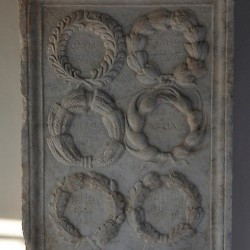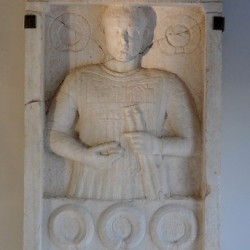Jona Lendering
Jona Lendering read history at Leiden University (MA 1993), specialized in Mediterranean culture at the Amsterdam Free University (MA 1996), and worked at excavations in Holland (Riethoven) and Greece (Halos). After teaching historical theory and ancient history at the Free University for several years, he was one of the founders of a school for history teaching, Livius Onderwijs. Born in Amsterdam, it has now spread to auxiliary locations in Bussum, Dronten, Gouda, Haarlem, Hoorn, Schagen, Zaanstad, and Zoetermeer. As of 2013, Livius Onderwijs has eight teachers, about 500-600 students a year, and offers tours to countries like Italy, Turkey, Iran, and Lebanon. The field trips help to etch into the students' minds some of what they've learned at the school.
Because history is for a large part telling a story, something you do best in your own language, Lendering prefers to publish in Dutch journals. However, he has contributed to the Bryn Mawr Classical Review and Ancient Warfare, while he is the founder of Ancient History Magazine. He is also the publisher and editor of the on-line publication of the Babylonian Chronicles of the Hellenistic Period, a set of important cuneiform sources for the history of the Seleucid and Parthian Near East, transcribed, translated and commented on by Bert van der Spek of the Free University Amsterdam and Irving Finkel of the British Museum. A publication as book is in preparation.
Lendering has written several books and maintains a blog in Dutch. He is the author of several books, including Edge of Empire and Consensus and Crises. For the Livius website, which has received several awards, he collaborates closely with Bill Thayer of LacusCurtius. Lendering is also the webmaster of two daily blogs, the MainzerBeobachter.com and Grondslagen.net.
There are 9380 items in Jona Lendering:

Isthmia, Victory Inscription |

Isthmia, Victory Inscription of Cornelius |
Isthmian Games
Isthmian GamesIsturgi (Andújar)
Isturgi: ancient town on the river Guadalquivir, modern Andújar. The Isturgi bridge The ancient town of Isturgi - sometimes erroneously identified with…Italica
Italica: Roman colony in western Andalusia, not far from Seville. Fortuna, or the City's Luck (Italica) Italica was founded in 206 BCE…Italica, Amphitheater
Italica: Roman colony in western Andalusia, not far from Seville. Its amphitheater is one of its best-preserved monuments. Seats in the…Italica, archaeological zone
Italica's main street, the cardo The site of Italica has for a substantial part been excavated. Among the oldest remains are…Italica, House of the Birds
Italica: Roman colony in western Andalusia, not far from Seville. Several second-century houses have been excavated. House of the Birds, general…Italica, House of the Neptune Mosaic
Italica: Roman colony in western Andalusia, not far from Seville. Several second-century houses have been excavated.The site of Italica has for a substantial part been excavated. The mansions of the Hadrianic quarter, however, are the main delight of a visit…Italica, House of the Planetarium
Italica: Roman colony in western Andalusia, not far from Seville. Several second-century houses have been excavated. Planetarium mosaic The site of Italica…Italica, museum pieces
Galba (Italica) Many objects from Italica are now in the Museo Arqueológico in Seville. One of these is a bust of…Iuliacum (Jülich)
Iuliacum: small town along the main road from Tongeren to Cologne (modern Jülich). Model of the Roman villa at Jülich-Hambach Iuliacum was…